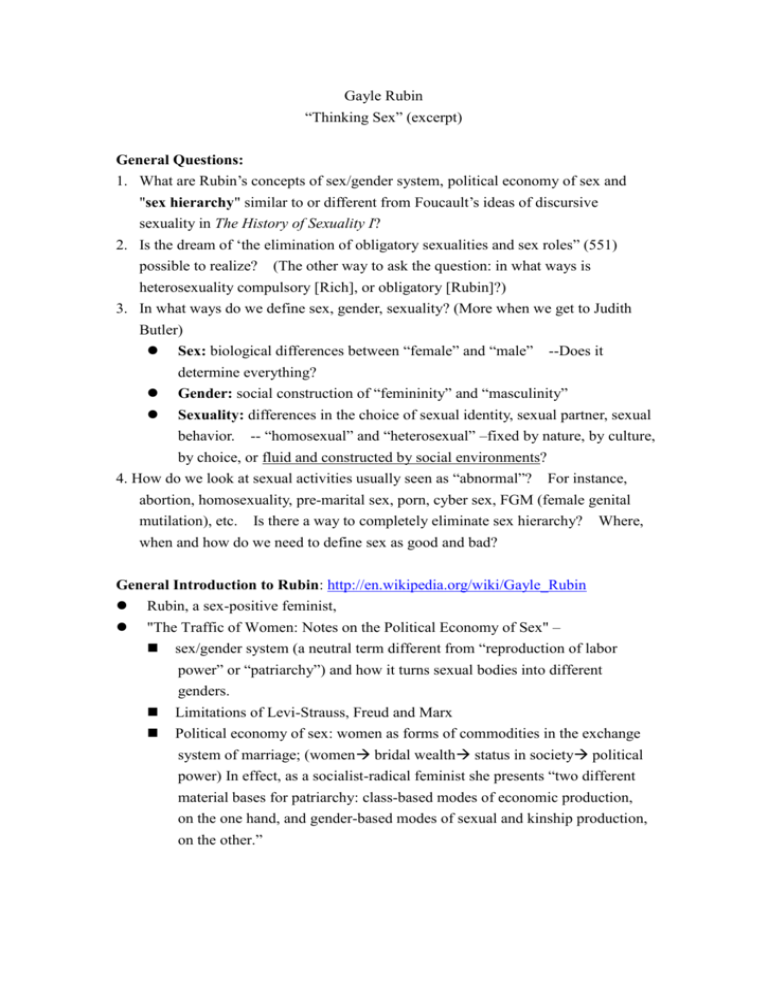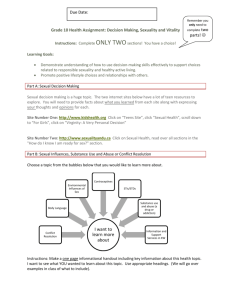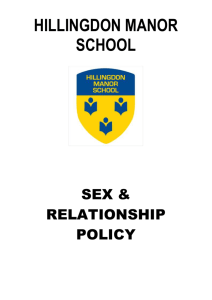
Gayle Rubin
“Thinking Sex” (excerpt)
General Questions:
1. What are Rubin’s concepts of sex/gender system, political economy of sex and
"sex hierarchy" similar to or different from Foucault’s ideas of discursive
sexuality in The History of Sexuality I?
2. Is the dream of ‘the elimination of obligatory sexualities and sex roles” (551)
possible to realize? (The other way to ask the question: in what ways is
heterosexuality compulsory [Rich], or obligatory [Rubin]?)
3. In what ways do we define sex, gender, sexuality? (More when we get to Judith
Butler)
Sex: biological differences between “female” and “male”
determine everything?
--Does it
Gender: social construction of “femininity” and “masculinity”
Sexuality: differences in the choice of sexual identity, sexual partner, sexual
behavior. -- “homosexual” and “heterosexual” –fixed by nature, by culture,
by choice, or fluid and constructed by social environments?
4. How do we look at sexual activities usually seen as “abnormal”? For instance,
abortion, homosexuality, pre-marital sex, porn, cyber sex, FGM (female genital
mutilation), etc. Is there a way to completely eliminate sex hierarchy? Where,
when and how do we need to define sex as good and bad?
General Introduction to Rubin: http://en.wikipedia.org/wiki/Gayle_Rubin
Rubin, a sex-positive feminist,
"The Traffic of Women: Notes on the Political Economy of Sex" –
sex/gender system (a neutral term different from “reproduction of labor
power” or “patriarchy”) and how it turns sexual bodies into different
genders.
Limitations of Levi-Strauss, Freud and Marx
Political economy of sex: women as forms of commodities in the exchange
system of marriage; (women bridal wealth status in society political
power) In effect, as a socialist-radical feminist she presents “two different
material bases for patriarchy: class-based modes of economic production,
on the one hand, and gender-based modes of sexual and kinship production,
on the other.”
Gayle Rubin, "Thinking Sex: Notes for a Radical Theory of the Politics of
Sexuality,"
(Ref. two outlines: http://www.mtsu.edu/~jaeller/dev03/porn.htm
http://www.csun.edu/CommunicationStudies/class/632/97s/rept/970413.hardey.html
〈性的雜想:情慾政治的基進理論〉
,271-278
女性主義經典 <fembooks13> 作者:顧燕翎,鄭至慧主編. 台北;女書,1999)
Main Argument: Unlike her previous argument, Rubin argues that sex should be
separated from gender, and that feminist theory should reconsider sexuality as
encompassing its own dynamics of sexual oppression, not reducible to the oppression
of women. (In contrast to my perspective in "The Traffic in Women." I am now
arguing that it is essential to separate gender and sexuality analytically to more
accurately reflect their separate social existence.)
I. The Sex Wars (since the 19th century)
II.
Sexual Thoughts –essentialism vs. constructivism (Foucault included)
C. The constructivist perspective does have some weak points. E.g.
misconstructions of Foucault’s position.
1. "Foucault has been vulnerable to interpretations that deny or minimize the
reality of sexual repression in the more political sense. Foucault makes it
abundantly clear that he is not denying the existence of sexual repression so much
as inscribing it within a large dynamic." (10).
2. We must recognize repressive phenomena without going back to the
essentialist perspective.
3. "It is often easier to fall back on the notion of a natural libido subjected to
inhumane repression than to reformulate concepts of sexual injustice within a more
constructivist framework. But it is essential that we do so" (11).
D. Five ideological formations on sex
1. sex negativity
2. the fallacy of misplaced scale
3. the hierarchical valuation of sex acts.
4. the domino theory of sexual peril
5. the lack of a concept of benign sexual variation.
The "sex hierarchy": -- two circles,
the inner circle: more acceptable types of sex, including procreative, married,
heterosexual and "vanilla" (standard sex).
the outer circle: "bad, abnormal and damned" sex such as non-procreative,
unmarried, homosexual and "with manufactured objects." (e.g. transvestites,
fetishists, SM, cross-generational sex and prostitution.) .
Diagram 2 explains where the lines are drawn between good and bad sex
Good sex
Major areas of contest
Bad sex
Normal, natural
unmarried heterosexual
couples
Abnormal, unnatural
healthy, holy
promiscuous
heterosexuals
Sick, sinful, way out
Heterosexual, married,
monogamous,
masturbation, long term
homosexual couples
transvestites transsexuals,
reproductive, at home
Fetishists, bed hopping
bar and Lesbians,
sadomasochists, gay men
for money,
cross-generational
I. Sexual morality has a lot in common with ideologies of racism.
1. It grants virtue to dominant groups.
2. A democratic morality should judge sexual acts by the way partners
treat one another, the level of mutual consideration, the presence o r absence of
coercision, and the quantity and quality of the pleasure they provide.
3. "It is difficult to develop a pluralistic sexual ethics without a concept
of benign sexual variation" (15).
III. Sexual Transformations
1. Industrialization and urbanization gave rise to a new sexual system.
2. Reconceptualize the new sexual system: “its social relations, the ideologies
which interpret it, and its characteristic mode of conflict.” (textbook 680)
e.g. of erotic speciation –Homosexual behaviors are treated differently in different
societies. “rewarded or punished, required or forbidden, a temporary experience or a
life-long vocation.” (textbook 680)
1) sexually motivated migration –to New York, Chicago, etc.
2) similar position-- prostitution//homosexuality: Prostitution –“Sex work is an
occupation, while sexual deviation is an erotic preference. Nevertheless, they share
some common features of social organization. Like homosexuals, prostitutes are a
criminal sexual population stigmatized on the basis of sexual activity.”
3) social space--“The perversions are not proliferating as much as they are attempting
to acquire social space, small businesses, political resources, and a measure of relief
from the penalties for sexual heresy” (textbook 681).
.
IV. Sexual Stratification
-- Sex law is probably the biggest contributor to stratification and erotic persecution.
-- It is unfortunate that laws like these exist, when the act occurs between two
consenting people. “Law like these criminalize sexual behavior that is freely chosen
and avidly thought”(21).
I.
What is considered deviant (charmed/bad wheel of sexuality) is the product of
political power that rewards some and punishes others.
II.
What makes sexuality deviant is an inappropriateness relative to one or another
of the following dimensions:
a. Degree of consent
b.
c.
d.
e.
f.
g.
Nature of the sexual object – who/what
Nature of the sex act
Setting
How often
For what purpose
Involvement of others
V. Sexual Conflicts
Consequences of sexual ideologies :
Sex acts on the good side “are accorded moral complexity.”
Sex acts on the bad side – get government controlled and socially stigmatized.
e.g. moral panics –in 1980’s: “The attacks on sadomasochists by a segment
of feminist movement, and the right’s increasing use of AIDS to incite
virulent homophobia.”
E.g. anti-porn feminists scapegoated SM imagery to reveal what
purportedly caused sexual violence against women. She argues that the
SM imagery is the consequence, but not the cause, of “how the West
eroticizes structures of domination and subordination.”
VI. The Limits of Feminism
Sexual radicals vs. anti-pornography movements
The emergent middle: has two points
a. "The first accusation that sexual dissidents have not paid close enough attention
to the meaning, sources, or historical construction of their sexuality" (30).
b. "The second part of the moderate position focuses on questions of consent.
Sexual radicals of all varieties have demanded the legal and social legitimization of
consenting sexual behavior" (30).
Conclusion:
"But an autonomous theory and politics specific to sexuality must
be developed" (34).








